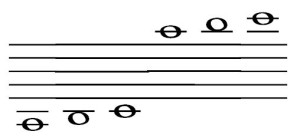| This reading music lesson is a supplement to the Alfred’s Essentials of Music Theory self-study workbook. While no book is perfect for learning how to read music, this is one of the best available. The concise explanations, brief practice exercises, ear-training CD’s, glossary of music terms, and answer key make it an excellent value. Buy this top-rated self-study course for beginners to advanced musicians and follow along with me. |
The best music theory book for self-study at home available today. Learn how to read and write music in 75 concise lessons you can complete at home. Improve your musical ear with ear-training exercises on 2 included CD's. Test yourself in a review section at the end of each unit. Check your knowledge with the answers in the back of the book.
Ledger lines are the small horizontal lines found above and below the music staff.
The purpose is to extend the staff either higher or lower.

Notes are placed on these little lines (or in between) giving us an even bigger range of sound.
History
Before someone came up with the idea of ledger lines, the clef sign would just move around in order to keep as many notes on the staff as possible.
This means the notes would change continually too. What a pain and a mess to keep track of!
So, the best solution was to keep the clef sign in one spot and just add-on the notes above and below the staff using ledger lines.
In the next lesson, we’ll take a look at some treble clef ledger lines.
Ledger Line Music Note Flashcards
A total of 72 cards featuring grand staff treble clef and bass clef notes, key signatures, intervals, and music symbols. The answers are included on the back. A great learning tool for beginner to intermediate piano players.
This all-in-one flashcard teaches the names of the music notes and where they are located on the grand staff. Ledger line notes are included. This is a great tool for beginner piano players learning how to read music.



